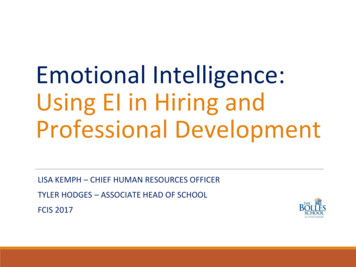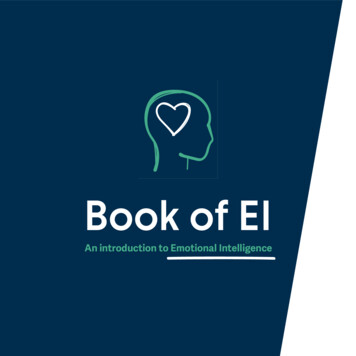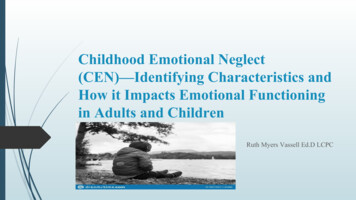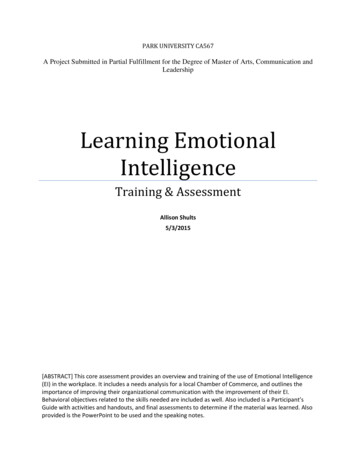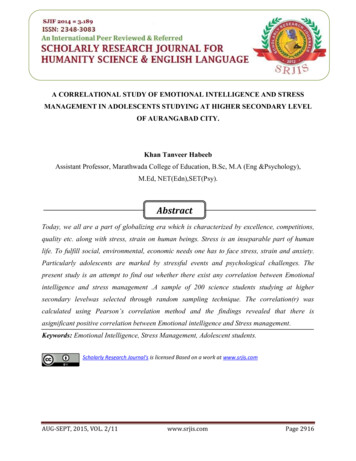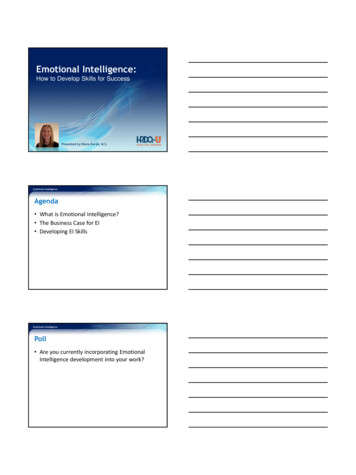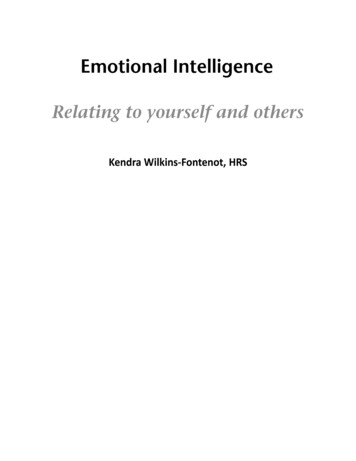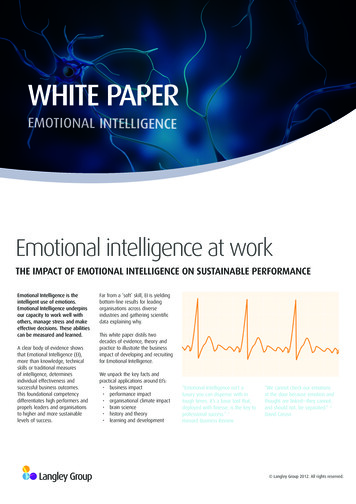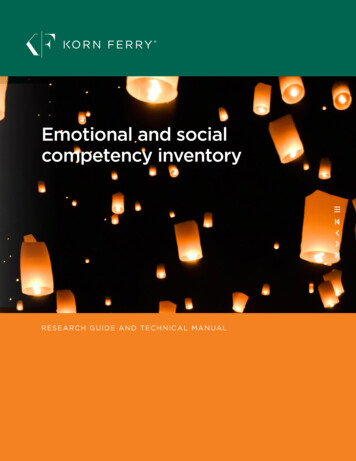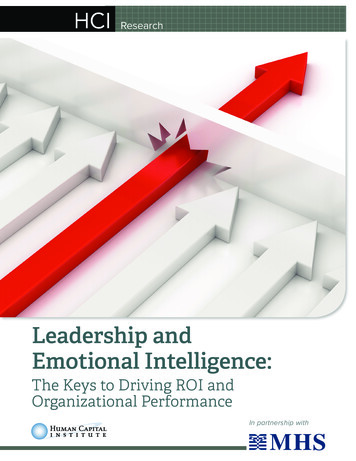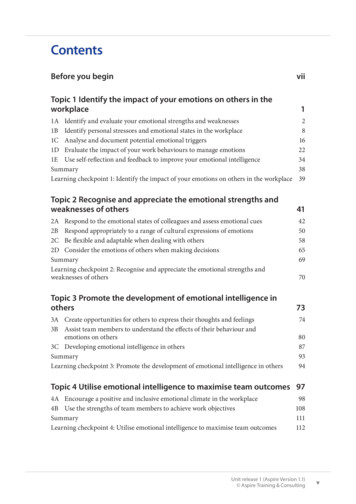
Transcription
ContentsBefore you begin viiTopic 1 Identify the impact of your emotions on others in theworkplace 11A Identify and evaluate your emotional strengths and weaknesses 21B Identify personal stressors and emotional states in the workplace 81C Analyse and document potential emotional triggers 161D Evaluate the impact of your work behaviours to manage emotions 221E Use self-reflection and feedback to improve your emotional intelligence 34Summary 38Learning checkpoint 1: Identify the impact of your emotions on others in the workplace 39Topic 2 Recognise and appreciate the emotional strengths andweaknesses of others 412A Respond to the emotional states of colleagues and assess emotional cues 422B Respond appropriately to a range of cultural expressions of emotions 502C Be flexible and adaptable when dealing with others 582D Consider the emotions of others when making decisions 65Summary 69Learning checkpoint 2: Recognise and appreciate the emotional strengths andweaknesses of others 70Topic 3 Promote the development of emotional intelligence inothers 733A Create opportunities for others to express their thoughts and feelings 743B Assist team members to understand the effects of their behaviour andemotions on others 803C Developing emotional intelligence in others 87Summary 93Learning checkpoint 3: Promote the development of emotional intelligence in others 94Topic 4 Utilise emotional intelligence to maximise team outcomes 974A Encourage a positive and inclusive emotional climate in the workplace 984B Use the strengths of team members to achieve work objectives 108Summary 111Learning checkpoint 4: Utilise emotional intelligence to maximise team outcomes 112Unit release 1 (Aspire Version 1.1) Aspire Training & Consultingv
Topic 1Identify the impact of your emotionson others in the workplaceAll people are creatures of emotion, whether they choose to be or not.We have instant, neurological, emotional responses to the things that happen around usevery day. Humans are built to connect with each other emotionally and our feelings arefundamental to our decision-making capabilities.The emotions associated with human interactions in the workplace have a powerful impacton the success and performance of individuals, teams, managers and organisations as awhole. With knowledge, training and experiential learning, frontline managers can learn tocontrol their own emotions in the workplace intentionally, instead of being ruled by them.In this topic you will learn how to:1A Identify and evaluate your emotional strengths and weaknesses1B Identify personal stressors and emotional states in the workplace1C Analyse and document potential emotional triggers1D Evaluate the impact of your work behaviours to manage emotions1E Use self-reflection and feedback to improve your emotional intelligenceUnit release 1 (Aspire Version 1.1) Aspire Training & Consulting1
BSBLDR511Develop and use emotional intelligenceEmotional signs Negative thoughts Disappointment in self Heightened emotional reactions Increased sensitivity Loneliness Loss of motivation Lack of self-confidence Mood swingsMental signs Confusion Lack of concentration Poor memory IndecisivenessBehavioural signs Changes in diet Increased smoking or drinking of alcohol Consumption of stress-related medication Nervousness Arriving late to work Taking time offTeam observations Increased staff turnover Complaints Staff illness or reports of stress Staff absences Poor performance Customer dissatisfaction Disputes within the team Unresolved personal conflicts between team members Difficulty in attracting new staff10Unit release 1 (Aspire Version 1.1) Aspire Training & Consulting
Topic 1Identify the impact of your emotions on others in the workplaceAlleviate workplace stressYour ability to remain calm in stressful situations makes it easier for teammembers to remain calm too.As a manager, it is essential that you discover ways to manage and reduce workplace stressto ensure your physical and emotional wellbeing, and that of your colleagues. The moreyou are able to manage your own stress, the more you will positively affect the people inyour team.If you are concerned that aspects of your job role or your team’s responsibilities arecontributing to stress levels, you should take prompt action to alleviate this, such asspeaking to senior management, consulting your human resources department orbrainstorming ways to reduce stress as a team.Below are some ways of reducing both personal and team stress in the workplace.Reducing personal workplace stress Learn better communication skills. Improve your relationships with colleagues and senior management. Identify negative attitudes or habits that add to the stress you experience. Take steps to improve your physical wellbeing, including having adequate sleep, ahealthy diet and doing aerobic exercise. Adopt better time-management skills, prioritise tasks and follow work schedules. Delegate responsibilities to team members where appropriate. Be willing to compromise on how you approach tasks. Avoid overcommitting yourself.Reducing team workplace stress Offer rewards and incentives. Show team members that they are valued. Provide opportunities for career development. Establish a zero-tolerance policy for harassment and discrimination. Clearly define job roles and responsibilities. Share information with colleagues to reduce uncertainty. Clearly communicate organisational policies and procedures. Praise good work performance, both formally and informally. Include employee contributions in decision-making. Communicate in a friendly and positive manner. Consult team members about scheduling and work tasks. Provide opportunities for social interaction. Support team members through coaching, mentoring and training.Unit release 1 (Aspire Version 1.1) Aspire Training & Consulting11
BSBLDR511Develop and use emotional intelligenceEmotional statesYour emotional state brings a certain set of feelings that come about with aparticular activity or under certain circumstances.For example, if a colleague accuses you of saying something you didn’t actually say, it islikely that you will feel angry as a consequence, even though you may not immediatelyperceive your own angry state. This rapid change in your emotional state will be evident byhow you respond verbally, as well as through your facial expression and body language.Identifying a particular emotional state can be difficult, particularly as you may experienceseveral different emotions at the same time. Every mood has a corresponding emotionalstate. Learning to understand your emotional states and those of your colleagues, as well ashow to deal with them, will help you to make better organisational decisions and formpositive relationships.Examples of emotional states are feeling: pleasant fearful kind amused disgusted anxious angry expectant frustrated happy.Here are some workplace stressors with examples of the emotional states that may arisefrom these triggers.Stressor or triggerLack of timeEmotional response Experiencing anxiety Making poor decisions Producing poor-quality work Becoming short-tempered and impatient with colleaguesToo many projects Experiencing fatigue Having high blood pressure Loss of motivationLack of clarity Experiencing self-doubt Feeling fatigued Experiencing confusion Feeling dissatisfied and unmotivated12Unit release 1 (Aspire Version 1.1) Aspire Training & Consulting
Topic 1Identify the impact of your emotions on others in the workplacePractice task 3Use this table to list six emotional triggers relating to your job, and identify the positive and negativeways that you might respond.Emotional triggerPositive responseNegative responseUnit release 1 (Aspire Version 1.1) Aspire Training & Consulting21
Topic 1Identify the impact of your emotions on others in the workplaceSocial awarenessSocial awareness means recognising the feelings of others, and knowing howand when to assist them.Managers must show empathy and respect for teammembers to better understand their perspectives,emotional states and particular needs. This facilitatespositive, safe and respectful workplace relationships.By developing empathy and listening to others, youwill become more attuned to how others feel andbe able to select the appropriate thing to say or doin any given situation. Social awareness enablesyou to promote a diverse, cross-cultural and nondiscriminatory workplace culture.The following outlines leadership capabilities thatdefine your competence in social awareness.EmpathyThis is sensing others’ emotions, understanding their perspectives, listening attentivelyand taking an active interest in their concerns. It involves getting along with people ofdiverse backgrounds and cultures.AwarenessThis involves understanding the current issues, decision networks and politics at theorganisational level. It involves detecting crucial social networks and understanding keypower relationships.ServiceThis is fostering an emotional climate so that people directly in touch with clients orcustomers will keep these relationships on track. It involves monitoring customersatisfaction carefully to ensure needs are met.Relationship managementRelationship management combines self-awareness, self-management andsocial awareness to effectively handle relationships in the workplace.Rather than showing mere friendliness, relationship management has a purpose: inspiring,motivating and moving people in the right organisational direction. Frontline managersmust tune into the emotions of team members to encourage positive and productiveworkplace interactions.By developing relationship management skills, you will learn how to find common ground,build rapport with your colleagues and develop valuable professional networks bothwithin and outside of your organisation. Relationship management skills help you to createa workplace where the sharing of ideas and information is encouraged, supported andcoordinated effectively.Unit release 1 (Aspire Version 1.1) Aspire Training & Consulting29
BSBLDR511Develop and use emotional intelligence1EUse self-reflection and feedback toimprove your emotional intelligenceSelf-reflection and feedback from others are both valuable tools in developingyour emotional intelligence.It is essential that you reflect on your personalattributes and consider the impact you have onothers. This assists you to modify your managementapproach and know where to focus to refine yourleadership strengths.As a manager, you should aim to create anatmosphere where the giving and receiving ofconstructive feedback is welcomed, appreciated andacted on. Managers who seek a full and accuratepicture of themselves from feedback and selfreflection will be well prepared to address theirstrengths and weaknesses.The importance of self-reflectionSelf-reflection involves thinking about, or reflecting on, what you do and howyou act.Self-reflection requires a conscious effort to think about specific events or situations, and todevelop insight into them. Reflective practices, or experiential learning, allow you to stepinto a new paradigm of thinking, reframing your ideas and thoughts in order to changewhat you do or how you feel.Taking time once a day to reflect on the day’s events, how people reacted to you or howwell you managed others requires a high degree of emotional intelligence. Conscientiousintrospection can cultivate emotional intelligence in everyone.Self-reflection allows you to: reframe your ideas and thoughts gain perspective about how your emotions affect you and your job performance understand your limitations and strengths be honest with yourself know when and where to ask for help know where to focus to develop and improve your leadership strengths have self-assurance about the things you are doing well.34Unit release 1 (Aspire Version 1.1) Aspire Training & Consulting
Topic 1Identify the impact of your emotions on others in the workplaceThe importance of feedbackThe path to self-awareness can be challenging, as it is often difficult to see inyourself what others see so easily.Seeking honest feedback on your leadership qualities is vital for developing your selfawareness. As a manager, it is important that you are conscious of what you are good at,while acknowledging the areas where you could improve. This includes owning up tomistakes and admitting when you do not have the answer.Feedback can encourage leaders to significantly modify their management approach, havinga ripple effect on the team and generating important changes throughout the organisation.Emotionally intelligent managers actively seek out negative feedback, understanding thevalue in gaining accurate views of how well they are performing as leaders. Less effectiveleaders most often seek positive feedback to confirm their own self-worth. Solicitingnegative or constructive feedback is vital to a leader’s continued growth and effectiveness inthe workplace.Feedback can be: formal or informal verbal, written or digital public or private ongoing or one-off immediate or periodic positive or constructive.Informal feedbackFeedback can be solicited through both formal and informal processes.You should choose a method that aligns with your organisational policies and procedures,and is appropriate in the context of the feedback sought.In the case of a dispute between yourself and another team member, feedback should begiven and received with all parties present so that it is fair and transparent.Tips for soliciting feedback Ask good questions relating to your performance, even if such questions elicitconstructive or negative feedback. Be open to all types of feedback, and demonstrate a willingness to learn from it. Accept feedback without defending yourself; otherwise people may stop giving youfeedback or you may miss what the person is trying to say. Create a bond of trust that enables the person giving feedback to feel as though theyhave helped to improve your performance. Do not pretend to know what the person giving the feedback is trying to say. Admit when you have made mistakes. When receiving feedback, always thank the person for their openness and honesty.Unit release 1 (Aspire Version 1.1) Aspire Training & Consulting35
BSBLDR511Develop and use emotional intelligenceProvide stability to team members during the planning phases of change Ensure your team members are provided with a period of stability leading up to a periodof organisational change. Reassure your team that management does not intend the change to be rushed, andprovide them with as many details as possible, including fixed dates, the workloadinvolved and mechanisms for employee consultation and feedback. Make draft change-management plans available and accessible for your team membersto review.Analyse the impact of change on employees, job roles and work responsibilities Be aware of the standard emotional reactions to change, so that you understand theextent to which organisational change will affect individual team members. For example,team members could react by retreating from the situation, rejecting the change,passively accepting it or challenging certain aspects of the change. Ensure you are fully informed about all aspects of the change yourself beforecommunicating it to your team to avoid expressing any uncertainty or confusion toyour team members. This may cause them to feel vulnerable or anxious about their jobsecurity.Provide meaningful work for team members during their transition It is important that during all stages of the organisational change, you provide meaningfulwork for your team members. Discuss with individuals the type of work they would prefer to do during any interimperiods when job roles may be ambiguous.Design a process to match employees to different jobs roles Design a method of matching jobs with the right individuals who have the requisite skills. Identify the level of support you are able to give your team members immediately aftertransferring into new roles or varying their current roles. Carefully formulate an action plan to assist employees and their representatives shouldthey not retain their current positions after the organisational change takes place. Where employees have the opportunity to apply for new or different positions withinthe organisation, or to be transferred to other teams or offices, ensure recruitment andselection processes are open, fair and equitable.Provide training to support team members Organisational change is unlikely to succeed without targeted training and developmentto assist team members in their transition. Relieve staff from their work responsibilities to attend training and development wherenecessary. Identify the key areas that require updated or additional skills and knowledge. Guide trainers with clear organisational objectives to assist them in preparing anddelivering training programs.62Unit release 1 (Aspire Version 1.1) Aspire Training & Consulting
BSBLDR511Develop and use emotional intelligenceLearning checkpoint 2Recognise and appreciate the emotionalstrengths and weaknesses of othersPart A1. Explain the difference between emotional responses and moods.2. Describe three ways to identify and assess the non-verbal emotional cues of colleagues.3. Describe three culturally intelligent communication behaviours for responding to theemotional cues of a diverse workforce.70Unit release 1 (Aspire Version 1.1) Aspire Training & Consulting
BSBLDR511Develop and use emotional intelligenceOpen communication is essential when you are part of a team that needs to increase itsproductivity because it can help to solve challenges so that your team can perform at its best.Tips for developing your team’s communication and active listening skills Consider putting your entire team through active listening training. Pay attention to the full communication of your team members – both verbal andnon-verbal – then feed it back to them to check your understanding. Encourage team members to ask questions, reflect on what has been said, clarifythe correct message and summarise the key points. Build understanding and empathy among your team members to help nurtureworkplace relationships. Let your team members know you have listened well by matching their emotions withwhat they have told you. Practise different styles of leading team meetings; for example, taking extra time tolisten and let others speak. Consider developing a formal tool for evaluating how aware team members are ofeach other’s emotions and how well these feelings are communicated within theteam. Demonstrate active listening skills by using positive reinforcement, smiling, makingeye contact and using a forward-facing posture.Meeting the needs of team membersHuman behaviour is generally motivated by the desire to improve quality oflife.Abraham Maslow developed a hierarchy of needs to understand what motivates people.Maslow’s theory suggests that an individual’s most basic level of needs must be met beforethe individual will focus on the secondary or higher level needs.Here is a diagram that shows how Maslow’s hierarchy is afetyPsysiological76Unit release 1 (Aspire Version 1.1) Aspire Training & -solving,lack of prejudice,acceptance of the factsSelf-esteem, confidence, achievement,respect of others, respect by othersFriendship, family, sexual intimacySecurity of body, employment, resources, morality, the family,health and propertyBreathing, food, water, sex, sleep, homeostasis, excretion
ExampleBSBLDR511Develop and use emotional intelligenceUsing team strengths to achieve workplace outcomesAs the sales team leader at a car dealership, Adam knowsthe huge benefits that come from knowing and tapping intothe strengths of his team members. For the car dealershipto retain its competitive edge, Adam makes it his priority todelegate tasks and responsibilities amongst his teammembers in ways that accomplish the highest amount ofsales as efficiently as possible.During his weekly team meetings, Adam asks his teammembers to identify any challenges they are facing inperforming their role. Leslie, a luxury car salesperson, shareswith the team that she is struggling to communicate effectively with her customers. Whileshe enjoys selling luxury cars and has good technical knowledge about the vehicle range,she doesn’t relate to the needs and preferences of her customers.Adam asks Leslie and the rest of the sales team to think about Leslie’s strengths anddiscuss how these could be best utilised within the business. Harrison points out thatLeslie is very popular with customers who have families with young children. Thesecustomers respond very positively to Leslie because she is a young mother herself and isable to provide personalised and informed advice.Adam suggests that Leslie could take her skills and expertise and apply them to sellingfamily-sized vehicles, including 4WDs and SUVs instead of the luxury car range. Sheagrees that this would make her feel more enthusiastic about her role.Practice task 14Question 1A client has threatened to move their business elsewhere after they have had a particularlypoor experience with the service they received from your company. The employee looking afterthat client’s account has been feeling stressed, and requested to move to another division. Youneed to assign one of your team members to managing the client. What strengths would you belooking for in the person you now assign to handle this client account?110Unit release 1 (Aspire Version 1.1) Aspire Training & Consulting
1A Identify and evaluate your emotional strengths and weaknesses 2 1B Identify personal stressors and emotional states in the workplace 8 1C Analyse and document potential emotional triggers 16 1D Evaluate the impact of your work behaviours to manage emotions 22 1E Use self-reflection and feedback to improve your emotional intelligence 34
